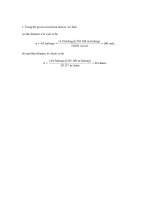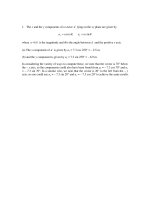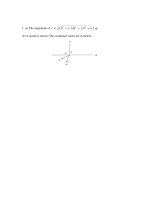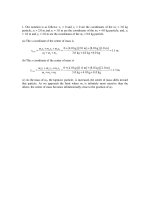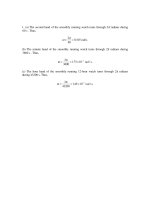Solution manual fundamentals of physics extended, 8th editionch16
Bạn đang xem bản rút gọn của tài liệu. Xem và tải ngay bản đầy đủ của tài liệu tại đây (838.16 KB, 100 trang )
1. (a) The motion from maximum displacement to zero is one-fourth of a cycle so 0.170 s
is one-fourth of a period. The period is T = 4(0.170 s) = 0.680 s.
(b) The frequency is the reciprocal of the period:
f =
1
1
=
= 1.47 Hz.
T 0.680 s
(c) A sinusoidal wave travels one wavelength in one period:
v=
λ
T
=
1.40 m
= 2.06 m s.
0.680s
2. (a) The angular wave number is
k=
2π
2π
=
= 3.49 m −1.
λ 1.80 m
(b) The speed of the wave is
v = λf =
λω (1.80 m )(110 rad s )
=
= 31.5 m s.
2π
2π
3. Let y1 = 2.0 mm (corresponding to time t1) and y2 = –2.0 mm (corresponding to time t2).
Then we find
kx + 600t1 + φ = sin−1(2.0/6.0)
and
kx + 600t2 + φ = sin−1(–2.0/6.0) .
Subtracting equations gives 600(t1 – t2) = sin−1(2.0/6.0) – sin−1(–2.0/6.0). Thus we find
t1 – t2 = 0.011 s (or 1.1 ms).
4. Setting x = 0 in u = − ω ym cos(k x − ω t + φ) (see Eq. 16-21 or Eq. 16-28) gives
u = − ω ym cos(−ω t + φ) as the function being plotted in the graph. We note that it has a
positive “slope” (referring to its t-derivative) at t = 0:
du
dt
=
d (−ω ym cos(−ω t+
dt
φ))
= − ym ω² sin(−ω t + φ) > 0 at t = 0.
This implies that – sinφ > 0 and consequently that φ is in either the third or fourth
quadrant. The graph shows (at t = 0) u = −4 m/s, and (at some later t) umax = 5 m/s. We
note that umax = ym ω. Therefore,
|t = 0
u = − umax cos(− ω t + φ)
φ = cos−1( 45 ) = ± 0.6435 rad
(bear in mind that cosθ = cos(−θ )), and we must choose φ = −0.64 rad (since this is
about −37° and is in fourth quadrant). Of course, this answer added to 2nπ is still a valid
answer (where n is any integer), so that, for example, φ = −0.64 + 2π = 5.64 rad is also an
acceptable result.
5. Using v = fλ, we find the length of one cycle of the wave is λ = 350/500 = 0.700 m =
700 mm. From f = 1/T, we find the time for one cycle of oscillation is T = 1/500 = 2.00 ×
10–3 s = 2.00 ms.
(a) A cycle is equivalent to 2π radians, so that π/3 rad corresponds to one-sixth of a cycle.
The corresponding length, therefore, is λ/6 = 700/6 = 117 mm.
(b) The interval 1.00 ms is half of T and thus corresponds to half of one cycle, or half of
2π rad. Thus, the phase difference is (1/2)2π = π rad.
6. (a) The amplitude is ym = 6.0 cm.
(b) We find λ from 2π/λ = 0.020π: λ = 1.0×102 cm.
(c) Solving 2πf = ω = 4.0π, we obtain f = 2.0 Hz.
(d) The wave speed is v = λf = (100 cm) (2.0 Hz) = 2.0×102 cm/s.
(e) The wave propagates in the –x direction, since the argument of the trig function is kx +
ωt instead of kx – ωt (as in Eq. 16-2).
(f) The maximum transverse speed (found from the time derivative of y) is
(
)
umax = 2π fym = 4.0 π s −1 ( 6.0 cm ) = 75cm s.
(g) y(3.5 cm, 0.26 s) = (6.0 cm) sin[0.020π(3.5) + 4.0π(0.26)] = –2.0 cm.
7. (a) Recalling from Ch. 12 the simple harmonic motion relation um = ymω, we have
ω=
16
= 400 rad/s.
0.040
Since ω = 2πf, we obtain f = 64 Hz.
(b) Using v = fλ, we find λ = 80/64 = 1.26 m ≈ 1.3 m .
(c) The amplitude of the transverse displacement is ym = 4.0 cm = 4.0 ×10−2 m.
(d) The wave number is k = 2π/λ = 5.0 rad/m.
(e) The angular frequency, as obtained in part (a), is ω = 16 / 0.040 = 4.0 × 102 rad/s.
(f) The function describing the wave can be written as
y = 0.040 sin ( 5 x − 400t + φ )
where distances are in meters and time is in seconds. We adjust the phase constant φ to
satisfy the condition y = 0.040 at x = t = 0. Therefore, sin φ = 1, for which the “simplest”
root is φ = π/2. Consequently, the answer is
π·
§
y = 0.040sin ¨ 5 x − 400t + ¸ .
©
2¹
(g) The sign in front of ω is minus.
8. With length in centimeters and time in seconds, we have
du
u = dt = 225π sin (πx − 15πt) .
Squaring this and adding it to the square of 15πy, we have
u2 + (15πy)2 = (225π )2 [sin2 (πx − 15π t) + cos2 (πx − 15π t)]
so that
u =
(225π)2 - (15πy)2 = 15π 152 - y2 .
Therefore, where y = 12, u must be ± 135π. Consequently, the speed there is 424 cm/s =
4.24 m/s.
9. (a) The amplitude ym is half of the 6.00 mm vertical range shown in the figure, i.e.,
ym = 3.0 mm.
(b) The speed of the wave is v = d/t = 15 m/s, where d = 0.060 m and t = 0.0040 s. The
angular wave number is k = 2π/λ where λ = 0.40 m. Thus,
k=
2π
= 16 rad/m .
λ
(c) The angular frequency is found from
ω = k v = (16 rad/m)(15 m/s)=2.4ͪ102 rad/s.
(d) We choose the minus sign (between kx and ωt) in the argument of the sine function
because the wave is shown traveling to the right [in the +x direction] – see section 16-5).
Therefore, with SI units understood, we obtain
y = ym sin(kx −kvt) ≈ 0.0030 sin(16 x − 2.4 ͪ10 t) .
2
10. The slope that they are plotting is the physical slope of sinusoidal waveshape (not to
be confused with the more abstract “slope” of its time development; the physical slope is
an x-derivative whereas the more abstract “slope” would be the t-derivative). Thus,
where the figure shows a maximum slope equal to 0.2 (with no unit), it refers to the
maximum of the following function:
dy
dx
=
(k x − ω t)
d ym sin
dx
= ym k cos(k x − ω t)
.
The problem additionally gives t = 0, which we can substitute into the above expression
if desired. In any case, the maximum of the above expression is ym k , where
k=
2π
λ
=
2π
= 15.7 rad/m .
0.40 m
Therefore, setting ym k equal to 0.20 allows us to solve for the amplitude ym . We find
ym =
0.20
= 0.0127 m ≈ 1.3 cm .
15.7 rad/m
11. From Eq. (16.10), a general expression for a sinusoidal wave traveling along the +x
direction is
y ( x, t ) = ym sin(kx − ω t + φ )
(a) Figure 16.34 shows that at x = 0, y (0, t ) = ym sin(−ω t + φ ) is a positive sine function,
i.e., y (0, t ) = + ym sin ω t. Therefore, the phase constant must be φ = π . At t =0, we then
have y ( x, 0) = ym sin(kx + π ) = − ym sin kx which is a negative sine function. A plot of y(x,0)
is depicted below.
y (x,0)
4
2
5
10
15
20
x(cm)
-2
-4
(b) From the figure we see that the amplitude is ym = 4.0 cm.
(c) The angular wave number is given by k = 2π/λ = π/10 = 0.31 rad/cm.
(d) The angular frequency is ω = 2π/T = π/5 = 0.63 rad/s.
(e) As found in part (a), the phase is φ = π .
(f) The sign is minus since the wave is traveling in the +x direction.
(g) Since the frequency is f = 1/T = 0.10 s, the speed of the wave is v = fλ = 2.0 cm/s.
(h) From the results above, the wave may be expressed as
§ π x πt
·
§ π x πt ·
y ( x, t ) = 4.0sin ¨
− + π ¸ = −4.0 sin ¨
− ¸.
© 10 5
¹
© 10 5 ¹
Taking the derivative of y with respect to t, we find
u ( x, t ) =
∂y
§ π·
§ π x πt ·
= 4.0 ¨ ¸ cos ¨
− ¸
∂t
©t¹
© 10 5 ¹
which yields u(0,5.0) = –2.5 cm/s.
12. The volume of a cylinder of height A is V = πr2 A = πd2 A /4. The strings are long,
narrow cylinders, one of diameter d1 and the other of diameter d2 (and corresponding
linear densities µ1 and µ2). The mass is the (regular) density multiplied by the volume: m
= ρV, so that the mass-per-unit length is
µ=
m ρ πd 2 A 4 πρ d 2
=
=
A
A
4
and their ratio is
2
µ1 πρ d12 4 § d1 ·
=
=¨ ¸ .
µ2 πρ d 22 4 © d 2 ¹
Therefore, the ratio of diameters is
d1
=
d2
µ1
3.0
=
= 3.2.
0.29
µ2
13. The wave speed v is given by v = τ µ , where τ is the tension in the rope and µ is
the linear mass density of the rope. The linear mass density is the mass per unit length of
rope: µ = m/L = (0.0600 kg)/(2.00 m) = 0.0300 kg/m. Thus
v=
500 N
= 129 m s.
0.0300 kg m
14. From v = τ µ , we have
τ
µ
vnew
= new new = 2.
vold
τ old µold
15. (a) The wave speed is given by v = λ/T = ω/k, where λ is the wavelength, T is the
period, ω is the angular frequency (2π/T), and k is the angular wave number (2π/λ). The
displacement has the form y = ym sin(kx + ωt), so k = 2.0 m–1 and ω = 30 rad/s. Thus
v = (30 rad/s)/(2.0 m–1) = 15 m/s.
(b) Since the wave speed is given by v = τ µ , where τ is the tension in the string and µ
is the linear mass density of the string, the tension is
τ = µ v 2 = (1.6 ×10−4 kg m ) (15 m s ) = 0.036 N.
2
16. We use v = τ / µ ∝ τ to obtain
2
2
§v ·
§ 180 m/s ·
τ 2 = τ1 ¨ 2 ¸ = (120 N ) ¨
¸ = 135N.
© 170 m/s ¹
© v1 ¹
17. (a) The amplitude of the wave is ym=0.120 mm.
(b) The wave speed is given by v = τ µ , where τ is the tension in the string and µ is the
linear mass density of the string, so the wavelength is λ = v/f = τ µ /f and the angular
wave number is
k=
2π
µ
0.50 kg m
= 2 πf
= 2π (100 Hz )
= 141m −1.
λ
τ
10 N
(c) The frequency is f = 100 Hz, so the angular frequency is
ω = 2πf = 2π(100 Hz) = 628 rad/s.
(d) We may write the string displacement in the form y = ym sin(kx + ωt). The plus sign is
used since the wave is traveling in the negative x direction. In summary, the wave can be
expressed as
y = ( 0.120 mm ) sin ª¬(141m −1 ) x + ( 628s −1 ) t º¼ .
18. (a) Comparing with Eq. 16-2, we see that k = 20/m and ω = 600/s. Therefore, the
speed of the wave is (see Eq. 16-13) v = ω/k = 30 m/s.
(b) From Eq. 16–26, we find
µ=
τ
v
2
=
15
= 0.017 kg m = 17 g m.
302
19. (a) We read the amplitude from the graph. It is about 5.0 cm.
(b) We read the wavelength from the graph. The curve crosses y = 0 at about x = 15 cm
and again with the same slope at about x = 55 cm, so
λ = (55 cm – 15 cm) = 40 cm = 0.40 m.
(c) The wave speed is v = τ / µ , where τ is the tension in the string and µ is the linear
mass density of the string. Thus,
v=
3.6 N
= 12 m/s.
25 × 10−3 kg/m
(d) The frequency is f = v/λ = (12 m/s)/(0.40 m) = 30 Hz and the period is
T = 1/f = 1/(30 Hz) = 0.033 s.
(e) The maximum string speed is
um = ωym = 2πfym = 2π(30 Hz) (5.0 cm) = 940 cm/s = 9.4 m/s.
(f) The angular wave number is k = 2π/λ = 2π/(0.40 m) = 16 m–1.
(g) The angular frequency is ω = 2πf = 2π(30 Hz) = 1.9×102 rad/s
(h) According to the graph, the displacement at x = 0 and t = 0 is 4.0 × 10–2 m. The
formula for the displacement gives y(0, 0) = ym sin φ. We wish to select φ so that 5.0 × 10–
2
sin φ = 4.0 × 10–2. The solution is either 0.93 rad or 2.21 rad. In the first case the
function has a positive slope at x = 0 and matches the graph. In the second case it has
negative slope and does not match the graph. We select φ = 0.93 rad.
(i) The string displacement has the form y (x, t) = ym sin(kx + ωt + φ). A plus sign appears
in the argument of the trigonometric function because the wave is moving in the negative
x direction. Using the results obtained above, the expression for the displacement is
y ( x, t ) = ( 5.0 × 10−2 m ) sin ª¬(16 m −1 ) x + (190s −1 )t + 0.93º¼ .
20. (a) The general expression for y (x, t) for the wave is y (x, t) = ym sin(kx – ωt), which,
at x = 10 cm, becomes y (x = 10 cm, t) = ym sin[k(10 cm – ωt)]. Comparing this with the
expression given, we find ω = 4.0 rad/s, or f = ω/2π = 0.64 Hz.
(b) Since k(10 cm) = 1.0, the wave number is k = 0.10/cm. Consequently, the wavelength
is λ = 2π/k = 63 cm.
(c) The amplitude is ym = 5.0 cm.
(d) In part (b), we have shown that the angular wave number is k = 0.10/cm.
(e) The angular frequency is ω = 4.0 rad/s.
(f) The sign is minus since the wave is traveling in the +x direction.
Summarizing the results obtained above by substituting the values of k and ω into the
general expression for y (x, t), with centimeters and seconds understood, we obtain
y ( x, t ) = 5.0sin (0.10 x − 4.0t ).
(g) Since v = ω /k = τ / µ , the tension is
τ=
ω 2µ
k2
(4.0 g / cm) (4.0s−1 ) 2
=
= 6400 g ⋅ cm/s2 = 0.064 N.
−1 2
(0.10cm )
21. The pulses have the same speed v. Suppose one pulse starts from the left end of the
wire at time t = 0. Its coordinate at time t is x1 = vt. The other pulse starts from the right
end, at x = L, where L is the length of the wire, at time t = 30 ms. If this time is denoted
by t0 then the coordinate of this wave at time t is x2 = L – v(t – t0). They meet when x1 = x2,
or, what is the same, when vt = L – v(t – t0). We solve for the time they meet: t = (L +
vt0)/2v and the coordinate of the meeting point is x = vt = (L + vt0)/2. Now, we calculate
the wave speed:
v=
τL
m
=
(250 N) (10.0 m)
= 158 m/s.
0.100 kg
Here τ is the tension in the wire and L/m is the linear mass density of the wire. The
coordinate of the meeting point is
x=
10.0 m + (158 m/s) (30.0 ×10−3 s)
= 7.37 m.
2
This is the distance from the left end of the wire. The distance from the right end is L – x
= (10.0 m – 7.37 m ) = 2.63 m.
22. (a) The tension in each string is given by τ = Mg/2. Thus, the wave speed in string 1 is
τ
Mg
(500 g) (9.80 m/s 2 )
v1 =
=
=
= 28.6 m/s.
2µ1
2(3.00 g/m)
µ1
(b) And the wave speed in string 2 is
v2 =
Mg
(500 g) (9.80 m/s 2 )
=
= 22.1m/s.
2µ2
2(5.00 g/m)
(c) Let v1 = M 1 g /(2µ1 ) = v2 = M 2 g /(2µ 2 ) and M1 + M2 = M. We solve for M1 and
obtain
M1 =
M
1 + µ 2 / µ1
=
500 g
= 187.5 g ≈ 188g.
1 + 5.00 / 3.00
(d) And we solve for the second mass: M2 = M – M1 = (500 g – 187.5 g) ≈ 313 g.
23. (a) The wave speed at any point on the rope is given by v = τ µ , where τ is the
tension at that point and µ is the linear mass density. Because the rope is hanging the
tension varies from point to point. Consider a point on the rope a distance y from the
bottom end. The forces acting on it are the weight of the rope below it, pulling down, and
the tension, pulling up. Since the rope is in equilibrium, these forces balance. The weight
of the rope below is given by µgy, so the tension is τ = µgy. The wave speed is
v = µ gy / µ = gy.
(b) The time dt for the wave to move past a length dy, a distance y from the bottom end, is
dt = dy v = dy gy and the total time for the wave to move the entire length of the rope
is
L
t=³
L
0
dy
y
=2
g
gy
=2
0
L
.
g
24. Using Eq. 16–33 for the average power and Eq. 16–26 for the speed of the wave, we
solve for f = ω/2π:
f =
1
2πym
2 Pavg
µ τ /µ
=
1
2π(7.70 ×10−3 m)
2(85.0 W)
= 198 Hz.
(36.0 N) (0.260 kg / 2.70 m )
